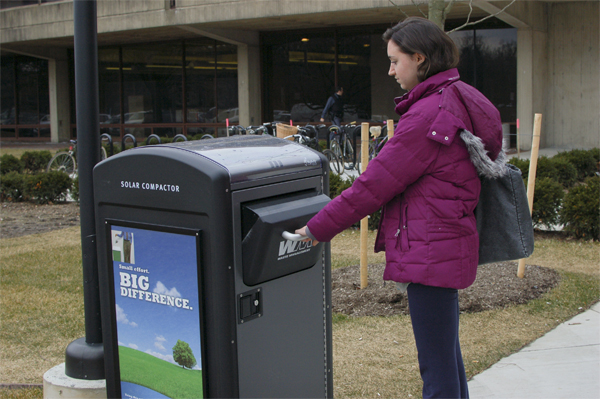

Facilities Management hopes to make the campus greener by introducing solar compactors and using sustainable materials in the renovations of the Sojournor Truth Library (STL) and the Wooster Science Building (WSB).
Five solar-powered trash compactors were installed on campus for free last month through a negotiation between SUNY New Paltz and Waste Management on their waste management contract, said Assistant Director of Facilities Operations Kim Nelson.
“I have been looking at [the solar-powered trash compactors] for a couple of years,” Nelson said. “But they were really expensive.”
The solar trash compactors are made out of recycled metals and self-powered by solar energy. It compresses trash so it doesn’t have to be emptied like non-compacting bins.
These devices are expected to lower fuel consumption and greenhouse gas emissions.
“Less pickups means less labor and less fuel to get to each [trash bin] to empty,” Nelson said. “This will not dramatically reduce fuels unless they were campus-wide.”
A solar and grid-connected photovoltaic panel is located on top of the bin to convert sunlight to electricity. There’s a compactor located inside the bin that “flattens out and crushes” trash.
In front of the solar-powered bins are a series of lights indicating when a trash bin needs to be emptied.
A green light means that there is plenty of room left in the bin, a yellow light means it’s close to being full and a red light means it’s full.
Each compactor contains a mini cell-phone that communicates bin-level information to Big Belly, the company that supplied the solar-powered trash compactors.
“It actually dials to the company, Big Belly,” Nelson said.
Anything that’s recyclable should not be placed into the bin. Recyclables will be “destroyed” in the bin, said Nelson. Solar-powered trash compactors should be located next to
recycle bins to prevent this from happening.
They are expected to last eight times longer than normal trash bins.
“We would be [monitoring] the number of times [the solar-trash compactors] have to be [emptied],” Nelson said.
She said she hopes to install more solar-powered trash compactors on campus in the future, as long as she likes the results.
Nelson said the campus will also be more efficient and environmentally friendly in terms of construction.
“The state of New York has mandated that all state agencies design to the Leadership in Energy and Environment Design (LEED),” said Nelson.
The designs for both WSB and STL are stepping up to be a LEED rated building. LEED consists of a rating system offering four certification levels based on green design categories such as sustainable sites, water efficiency, materials, resources and indoor environmental quality.
Director of Facilities, Design and Construction John McEnrue said the new design for WSB will “embody the building intelligence and environmental insights that have been so transformational to the environment over the last 30 years.”
The new design for WSB will include thermal insulated glass on all sides, reducing energy consumption. McEnrue said the current structure of WSB serves as an “energy vacuum.”
The building materials for the renovations WSB and STL will include recycled and sustainable materials.
Brian Obach, chair for the sociology department and member of the Environmental Task Force, said he likes the fact that the campus is visually demonstrating the usefulness of solar energy.
“It demonstrates that there’s energy that we can harvest all around,” said Obach. “I like to see the use of solar energy whenever.”
